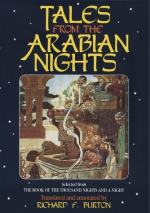[FN#93] Arab. “Bilad al-Sudan"=the Land of the Blacks, negro-land, whence the slaves came, a word now fatally familiar to English ears. There are, however, two regions of the same name, the Eastern upon the Upper Nile and the Western which contains the Niger Valley, and each considers itself the Sudan. And the reader must not confound the Berber of the Upper Nile, the Berderino who acts servant in Lower Egypt, with the Berber of Barbary: the former speaks an African language; the latter a “Semitic” (Arabic) tongue.
[FN#94] “Him” for “her.”
[FN#95] Arab. “Saibah,” a she-camel freed from labour under certain conditions amongst the pagan Arabs; for which see Sale (Prel. Disc. sect. v.).
[FN#96] Arab. “Marba’.” In early spring the Badawi tribes leave the Rasm or wintering-place (the Turco-Persian “Kishlak”) in the desert, where winter-rains supply them, and make for the Yaylak, or summer-quarters, where they find grass and water. Thus the great Ruwala tribe appears regularly every year on the eastern slopes of the Anti-Libanus (Unexplored Syria, i. 117), and hence the frequent “partings.”
[FN#97] This “renowning it” and boasting of one’s tribe (and oneself) before battle is as natural as the war-cry: both are intended to frighten the foe and have often succeeded. Every classical reader knows that the former practice dates from the earliest ages. It is still customary in Arabia during the furious tribal fights, the duello on a magnificent scale which often ends in half the combatants on either side being placed hors-de-combat. A fair specimen of “renowning it” is Amru’s Suspended Poem with its extravagant panegyric of the Taghlab tribe (p. 64, “Arabian Poetry for English Readers,” etc., by W. A. Clouston, Glasgow: privately printed MDCCCLXXXI.; and transcribed from Sir William Jones’s translation).
[FN#98] The “Turk” appeared soon amongst the Abbaside Caliphs. Mohammed was made to prophecy of them under the title Banu Kanturah, the latter being a slave-girl of Abraham. The Imam Al-Shafi’i (A.H. 195=A.D. 810) is said to have foretold their rule in Egypt where an Ottoman defended him against a donkey-boy. (For details see Pilgrimage i. 216 ) The Caliph Al-Mu’atasim bi’llah (A.D. 833-842) had more than 10,000 Turkish slaves and was the first to entrust them with high office; so his Arab subjects wrote of him:—
A wretched Turk is thy
heart’s desire;
And to them thou showest
thee dam and sire.
His successor Al-Wasik (Vathek, of the terrible eyes) was the first to appoint a Turk his Sultan or regent. After his reign they became praetorians and led to the downfall of the Abbasides.
[FN#99] The Persian saying is “First at the feast and last at the fray.”
[FN#100] i.e. a tempter, a seducer.
[FN#101] Arab. “Wayl-ak” here probably used in the sense of “Wayh-ak” an expression of affectionate concern.




